Coastal Bathymetric Sounding in Very Shallow Water Using USV: Study of Public Beach in Gdynia, Poland
Abstract
1. Introduction
2. Materials and Methods
2.1. General Methodology of Survey Lines’ Planning Using SBES
2.2. Planning of Survey Lines in Restricted Areas
2.3. Water Level Observation and Prediction
- mobile water level gauge stations, often referred to as tide-gauge or tide-stations. They usually make use of special pressure and temperature sensors, which measure changes in the water column and use the registered changes to convert the data, referring them to the water level changes;
2.4. USV Used for Bathymetric Surveys in Very Shallow Water
3. Results and Discussion
3.1. Area of the Research
3.2. Determination the Sounding Boundary
4. Conclusions
Funding
Institutional Review Board Statement
Informed Consent Statement
Data Availability Statement
Conflicts of Interest
References
- Stateczny, A.; Grońska, D.; Motyl, W. Hydrodron—New step for professional hydrography for restricted waters. In Proceedings of the 2018 Baltic Geodetic Congress, Olsztyn, Poland, 21–23 June 2018. [Google Scholar]
- Specht, C.; Świtalski, E.; Specht, M. Application of an autonomous/unmanned survey vessel (ASV/USV) in bathymetric measurements. Pol. Marit. Res. 2017, 24, 36–44. [Google Scholar] [CrossRef]
- Tanakitkorn, K. A review of unmanned surface vehicle development. Marit. Tech. Res. 2019, 1, 2–8. [Google Scholar] [CrossRef]
- Strickland, J.; Devine, T. Unmanned Surface Vehicles: Realizations & Applications. In Proceedings of the 11th Symposium on High Speed Marine Vehicles, Naples, FL, USA, 25–26 October 2017. [Google Scholar]
- Popielarczyk, D.; Marschalko, M.; Templin, T.; Niemiec, D.; Yilmaz, I.; Matuszková, B. Bathymetric Monitoring of Alluvial River Bottom Changes for Purposes of Stability of Water Power Plant Structure with a New Methodology for River Bottom Hazard Mapping (Wloclawek, Poland). Sensors 2020, 20, 5004. [Google Scholar] [CrossRef]
- Popielarczyk, D.; Templin, T.; Łopata, M. Using the geodetic and hydroacoustic measurements to investigate the bathymetric and morphometric parameters of Lake Hancza (Poland). Open Geosci. 2015, 7, 854–869. [Google Scholar] [CrossRef]
- Popielarczyk, D.; Templin, T. Application of Integrated GNSS/Hydroacoustic Measurements and GIS Geodatabase Models for Bottom Analysis of Lake Hancza. Pure Appl. Geophys. 2014, 171, 997–1011. [Google Scholar] [CrossRef]
- Nikishin, V.; Durmanov, M.; Skorik, I. Autonomous Unmanned Surface Vehicle for Water Surface Monitoring. TransNav Int. J. Mar. Nav. Saf. Sea Tran. 2020, 14, 853–858. [Google Scholar] [CrossRef]
- Jin, J.; Zhang, J.; Shao, F.; Lyu, Z.; Wang, D. A novel ocean bathymetry technology based on an unmanned surface vehicle. Acta Oceanol. Sin. 2018, 37, 99–106. [Google Scholar] [CrossRef]
- Zhang, S.; Ran, W.; Liu, G.; Li, Y.; Xu, Y. A Multi-Agent-Based Defense System Design for Multiple Unmanned Surface Vehicles. Electronics 2022, 11, 2797. [Google Scholar] [CrossRef]
- Marchel, Ł.; Specht, C.; Specht, M. Assessment of the Steering Precision of a Hydrographic USV along Sounding Profiles Using a High-Precision GNSS RTK Receiver Supported Autopilot. Energies 2020, 13, 5637. [Google Scholar] [CrossRef]
- Stateczny, A.; Burdziakowski, P.; Najdecka, K.; Domagalska-Stateczna, B. Accuracy of Trajectory Tracking Based on Nonlinear Guidance Logic for Hydrographic Unmanned Surface Vessels. Sensors 2020, 20, 832. [Google Scholar] [CrossRef]
- Specht, C.; Makar, A.; Specht, M. Availability of the GNSS geodetic networks position during the hydrographic surveys in the ports. TransNav Int. J. Mar. Navig. Saf. Sea Transp. 2018, 12, 657–661. [Google Scholar] [CrossRef]
- Jang, W.S.; Park, H.S.; Seo, K.Y.; Kim, Y.K. Analysis of positioning accuracy using multi differential GNSS in coast and port area of South Korea. J. Coast. Res. 2016, 75, 1337–1341. [Google Scholar] [CrossRef]
- Makar, A. Dynamic Tests of ASG-EUPOS Receiver in Hydrographic Application. In Proceedings of the 18th International Multidisciplinary Scientific GeoConference SGEM, Albena, Bulgaria, 30 June–9 July 2018; Volume 18, pp. 743–750. [Google Scholar]
- International Hydrographic Organization. Special Publication S-44, Standards for Hydrographic Surveys, 6th ed.; International Hydrographic Organization: Monaco, 2019. [Google Scholar]
- Canadian Hydrographic Service. Standards for Hydrographic Surveys, 2nd ed.; International Hydrographic Organization: Ottawa, ON, Canada, 2013. [Google Scholar]
- Ministry of Defence of the Republic of Poland. Act of 28 March 2018 on the Minimum Standards for Hydrographic Surveys; Ministry of Defence of the Republic of Poland: Warsaw, Poland, 2018. [Google Scholar]
- Specht, M. Method of evaluating the positioning system capability for complying with the minimum accuracy requirements for the international hydrographic organization orders. Sensors 2019, 19, 3860. [Google Scholar] [CrossRef] [PubMed]
- Hydrographic Office of the Polish Navy. Maritime Hydrography—Rules of Data Collecting and Results Presentation; Hydrographic Office of the Polish Navy: Gdynia, Poland, 2009.
- International Federation of Surveyors (FIG). Guidelines for the Planning, Execution and Management of Hydrographic Surveys in Ports and Harbours; FIG Publication No 56; International Federation of Surveyors (FIG): Copenhagen, Denmark, 2010. [Google Scholar]
- New Zealand Government. Good Practice Guidelines for Hydrographic Surveys in New Zealand Ports and Harbours; New Zealand Government: Wellington, New Zealand, 2020. [Google Scholar]
- Specht, M.; Specht, C.; Szafran, M.; Makar, A.; Dąbrowski, P.; Lasota, H.; Cywiński, P. The Use of USV to Develop Navigational and Bathymetric Charts of Yacht Ports on the Example of National Sailing Centre in Gdańsk. Remote Sens. 2020, 12, 2585. [Google Scholar] [CrossRef]
- Makar, A.; Specht, C.; Specht, M.; Dąbrowski, P.; Szafran, M. Integrated Geodetic and Hydrographic Measurements of the Yacht Port for Nautical Charts and Dynamic Spatial Presentation. Geosciences 2020, 10, 203. [Google Scholar] [CrossRef]
- Makar, A. Determination of the Minimum Safe Distance between a USV and a Hydro-Engineering Structure in a Restricted Water Region Sounding. Energies 2022, 15, 2441. [Google Scholar] [CrossRef]
- International Hydrographic Organization. Specifications for Chart Content and Display Aspects of ECDIS, 6.1(.1) ed.; International Hydrographic Organization: Monaco, 2014. [Google Scholar]
- Hydrographic Office of the Polish Navy. The Guidebook in Terms of Marks and Symbols Used in ENC and ECDIS; Publication No 540; Hydrographic Office of the Polish Navy: Gdynia, Poland, 2020. (In Polish) [Google Scholar]
- Rutkowski, G. ECDIS Limitations, Data Reliability, Alarm Management and Safety Settings Recommended for Passage Planning and Route Monitoring on VLCC Tankers. TransNav Int. J. Mar. Navig. Saf. Sea Transp. 2018, 12, 483–490. [Google Scholar] [CrossRef]
- Rutkowski, G. Determining the Best Possible Speed of the Ship in Shallow Waters Estimated Based on the Adopted Model for Calculation of the Ship’s Domain Depth. Pol. Marit. Res. 2020, 27, 140–148. [Google Scholar] [CrossRef]
- Novaselic, M.; Mohović, R.; Baric, M.; Grbić, L. Wind Influence on Ship Manoeuvrability—A Turning Circle Analysis. TransNav Int. J. Mar. Navig. Saf. Sea Transp. 2021, 15, 47. [Google Scholar] [CrossRef]
- Cui, J.; Wu, Z.; Chen, W. Research on Prediction of Ship Manoeuvrability. J. Shipp. Ocean. Eng. 2018, 8. [Google Scholar] [CrossRef]
- Burdziakowski, P.; Stateczny, A. Universal Autonomous Control and Management System for Multipurpose Unmanned Surface Vessel. Pol. Mar. Res. 2019, 26, 30–39. [Google Scholar] [CrossRef]
- Council of Ministers of the Republic of Poland. Ordinance of the Council of Ministers of 15 October 2012 on the National Spatial Reference System; Council of Ministers of the Republic of Poland: Warsaw, Poland, 2012. (In Polish)
- Medvedev, I.P.; Rabinovich, A.B.; Kulikov, E.A. Tidal oscillations in the Baltic Sea. Oceanology 2013, 53, 526–538. [Google Scholar] [CrossRef]
- Merrifield, M.; Aarup, T.; Allen, A.; Aman, A.; Caldwell, P.; Bradshaw, E.; Fernandes, R.M.S.; Hayashibara, H.; Hernandez, F.; Kilonsky, B.; et al. The Global Sea Level Observing System (GLOSS). In Proceedings of the OceanObs’09: Sustained Ocean Observations and Information for Society, Venice, Italy, 21–25 September 2009; Hall, J., Harrison, D.E., Stammer, D., Eds.; ESA Publication: Auckland, New Zealand; Volume 2. [Google Scholar]
- Bradshaw, E.; Rickards, L.; Aarup, T. Sea level data archaeology and the Global Sea Level Observing System (GLOSS). GeoResJ 2015, 6, 9–16. [Google Scholar] [CrossRef]
- Boski, T.; Wilamowski, A. Sea level changes—Causes, time scales and the history of their recognition. Prz. Geol. 2020, 68, 820–823. [Google Scholar]
- Ecohydrodynamic Model. Available online: http://model.ocean.univ.gda.pl/php/frame.php?area=ZatokaGdanska (accessed on 15 June 2022).
- Ołdakowski, B.; Kowalewski, M.; Jędrasik, J.; Szymelfenig, M. Ecohydrodynamic Model of the Baltic Sea, Part I: Description of the ProDeMo model. Oceanologia 2005, 47, 477–516. [Google Scholar]
- Kowalewska-Kalkowska, H.; Kowalewski, M.; Wiśniewski, B. The forecasting of hydrodynamic conditions in the Odra River mouth using hydrodynamic model of the Baltic Sea (M3D_UG). Pol. J. Env. St. 2007, 16, 26–31. [Google Scholar]
- Kowalewska-Kalkowska, H.; Kowalewski, M. Observations and modelling of extreme sea level events in the coastal waters of the Pomeranian Bay. In Proceedings of the Storm Surges Congress, Hamburg, Germany, 13–17 September 2010. [Google Scholar]
- Rogowski, J.B.; Galas, R.; Kłęk, M. Determination of Seabed Heights in the Area of Polish Territorial Waters in the Official Reference System. TransNav Int. J. Mar. Navig. Saf. Sea Transp. 2020, 14, 339–342. [Google Scholar] [CrossRef]
- Popielarczyk, D. RTK Water Level Determination in Precise Inland Bathymetric Measurements. In Proceedings of the 25th International Technical Meeting of the Satellite Division of the Institute of Navigation (ION GNSS 2012), Nashville, TN, USA, 17–21 September 2012; pp. 1158–1163. [Google Scholar]
- Hydrological Stations. Gdynia (154180120). Available online: https://hydro.imgw.pl/#station/hydro/154180120 (accessed on 15 June 2022).
- Makar, A. Determination of USV’s Direction Using Satellite and Fluxgate Compasses and GNSS-RTK. Sensors 2022, 22, 7895. [Google Scholar] [CrossRef]
- Makar, A. Limitations of Multi-GNSS Positioning of USV in Area with High Harbour Infrastructure. Electronics 2023, 12, 697. [Google Scholar] [CrossRef]
- Specht, M.; Specht, C.; Stateczny, A.; Marchel, Ł.; Lewicka, O.; Paliszewska-Mojsiuk, M.; Wiśniewska, M. Determining the Seasonal Variability of the Territorial Sea Baseline in Poland (2018–2020) Using Integrated USV/GNSS/SBES Measurements. Energies 2021, 14, 2693. [Google Scholar] [CrossRef]
- Lewicka, O.; Specht, M.; Stateczny, A.; Specht, C.; Dardanelli, G.; Brčić, D.; Szostak, B.; Halicki, A.; Stateczny, M.; Widźgowski, S. Integration Data Model of the Bathymetric Monitoring System for Shallow Waterbodies Using UAV and USV Platforms. Remote Sens. 2022, 14, 4075. [Google Scholar] [CrossRef]
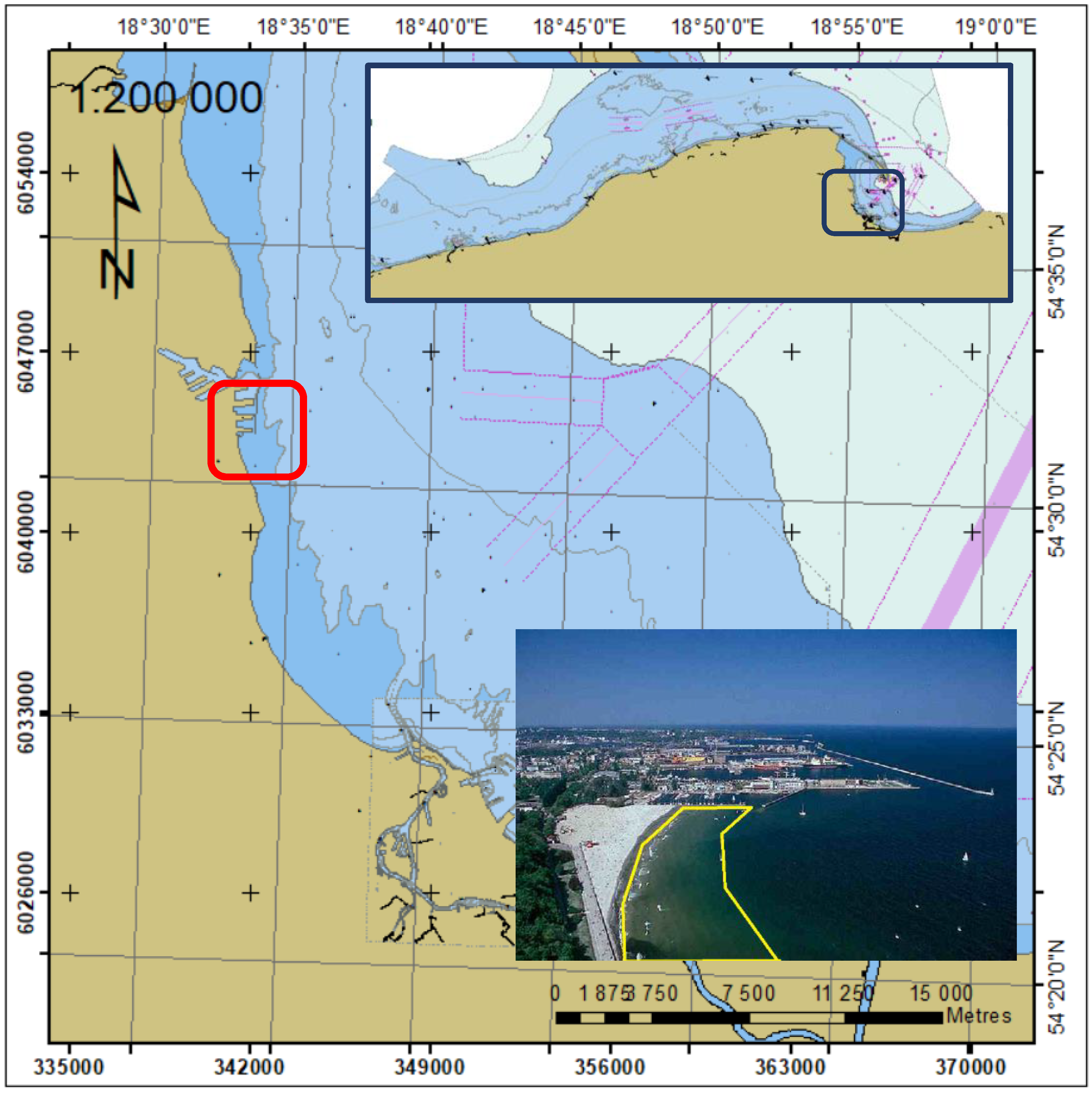




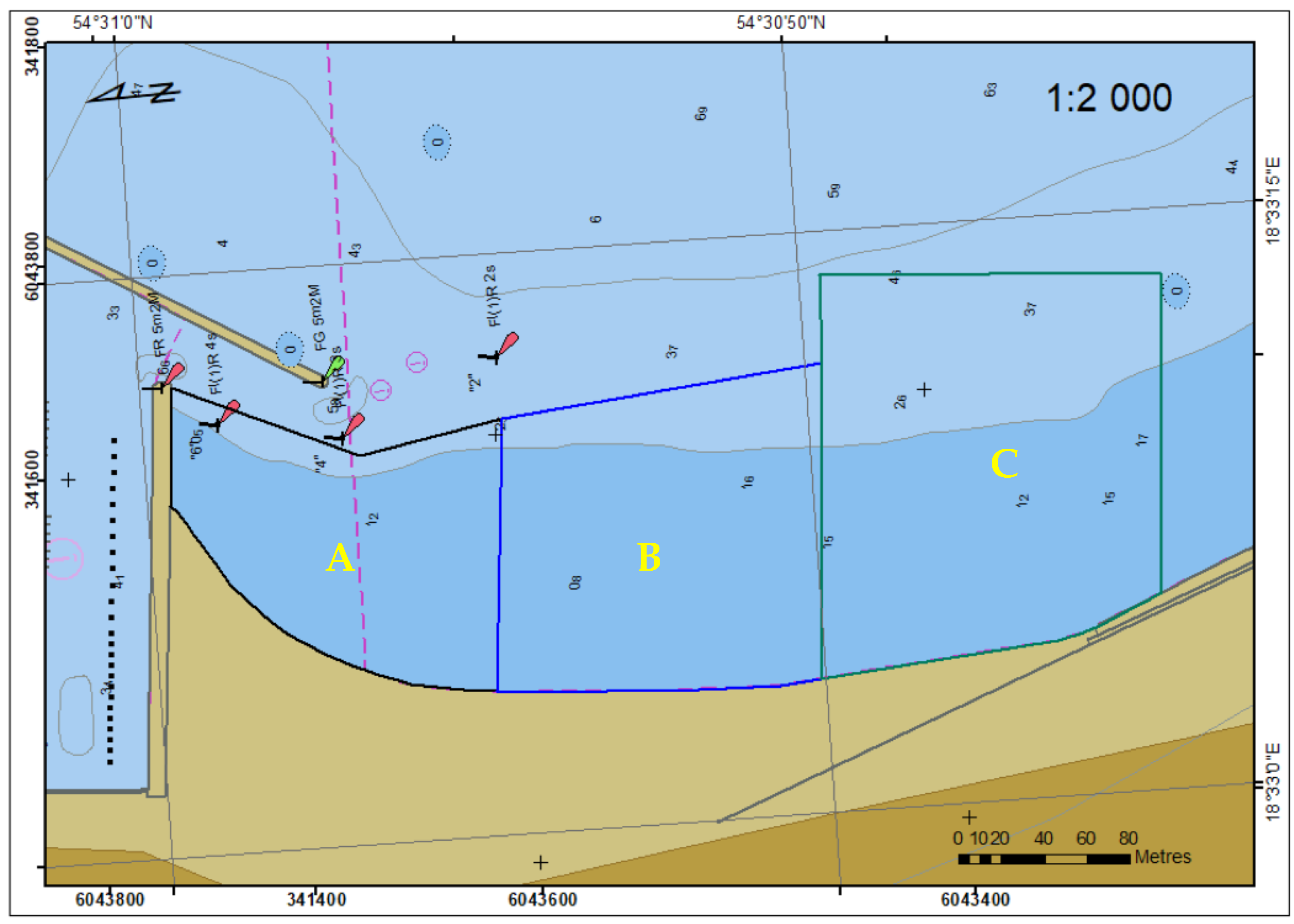
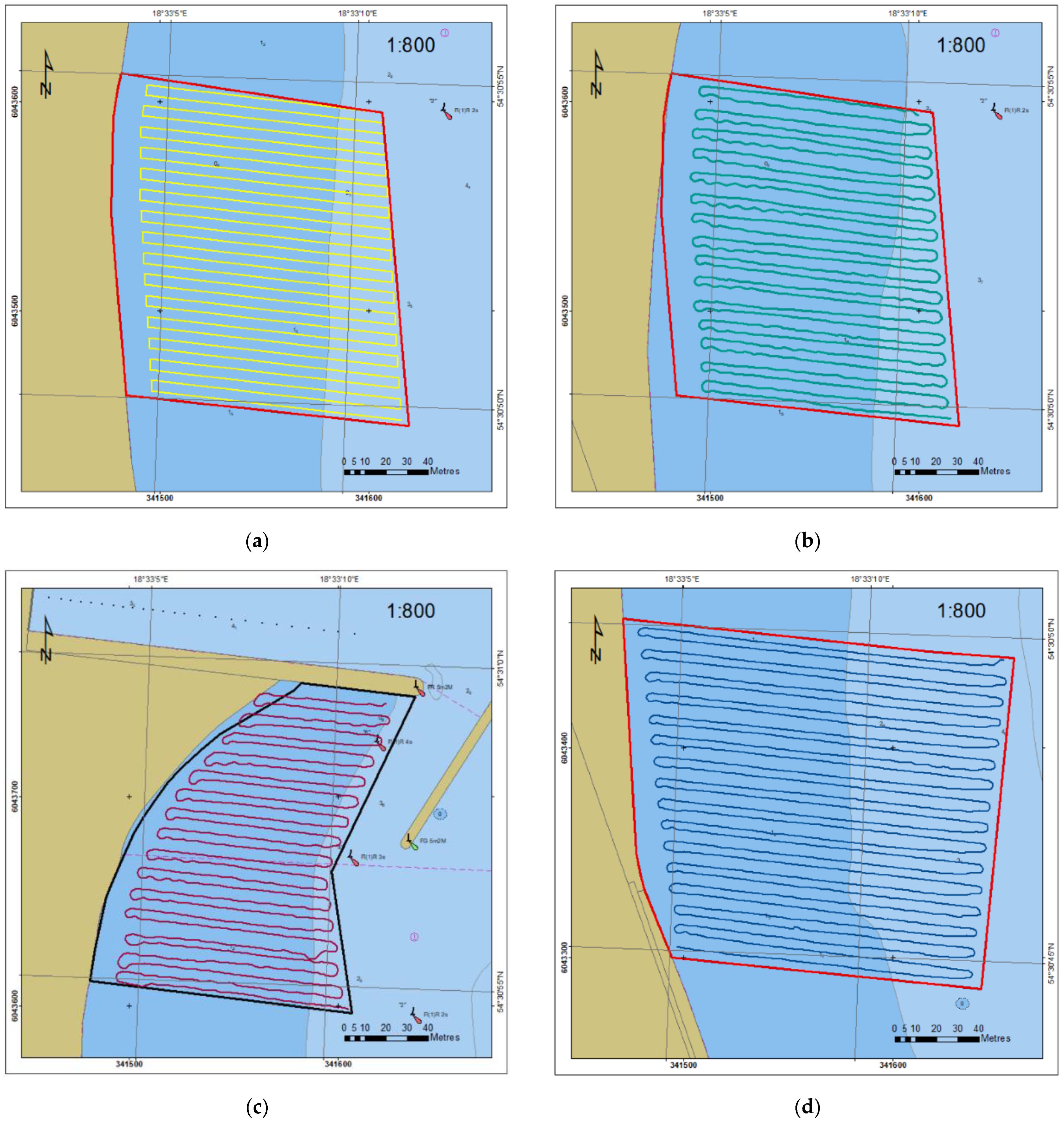
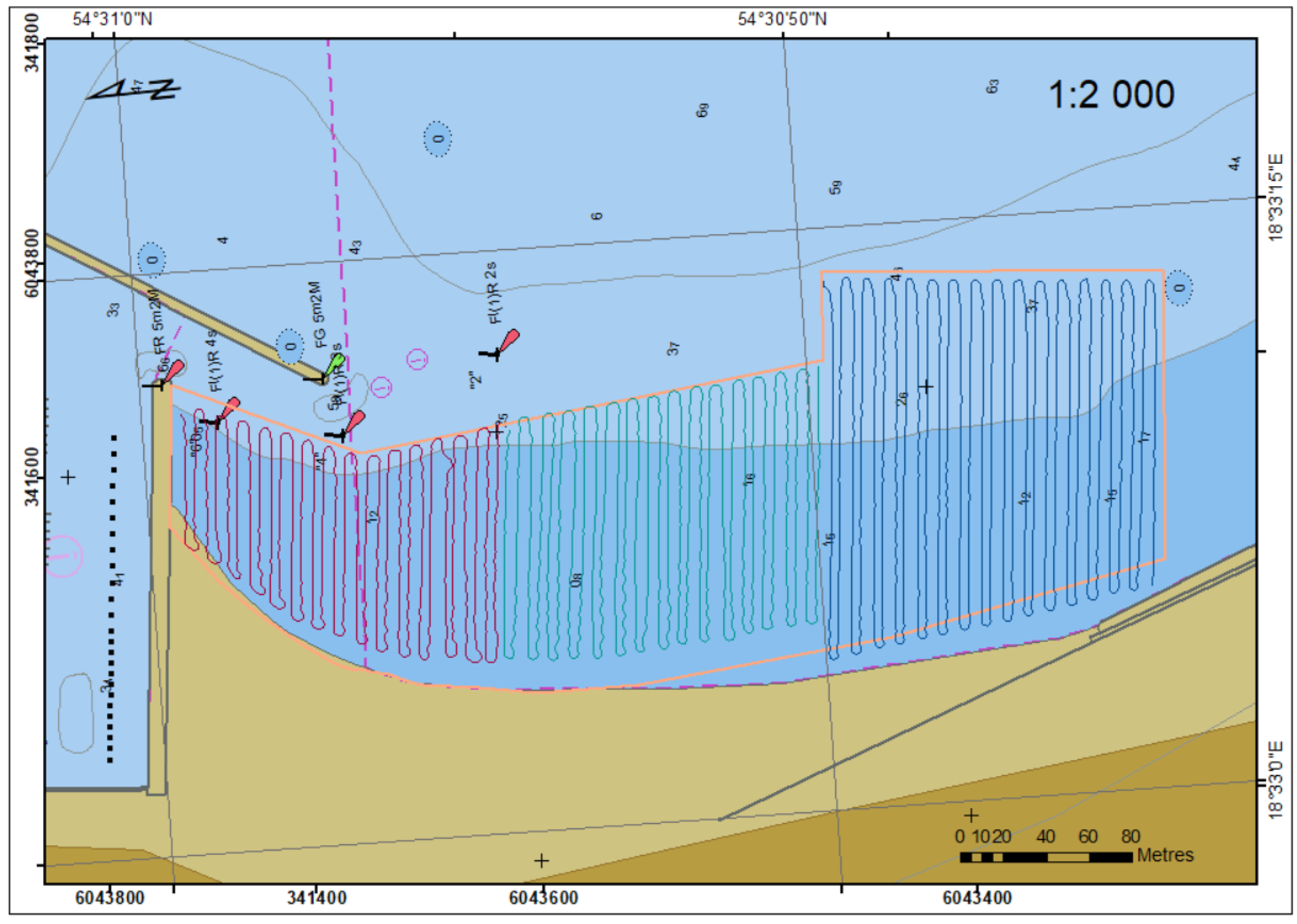

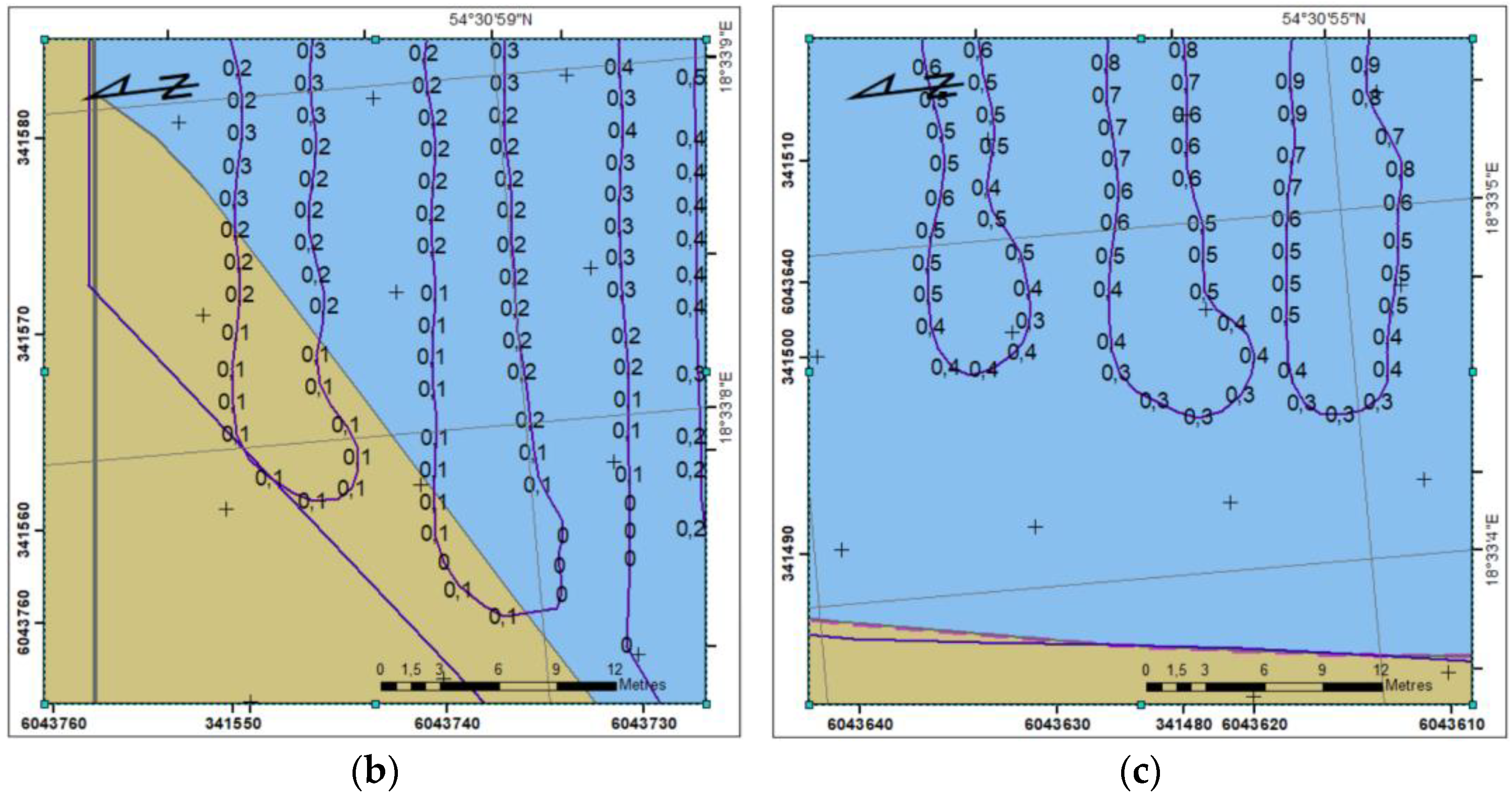
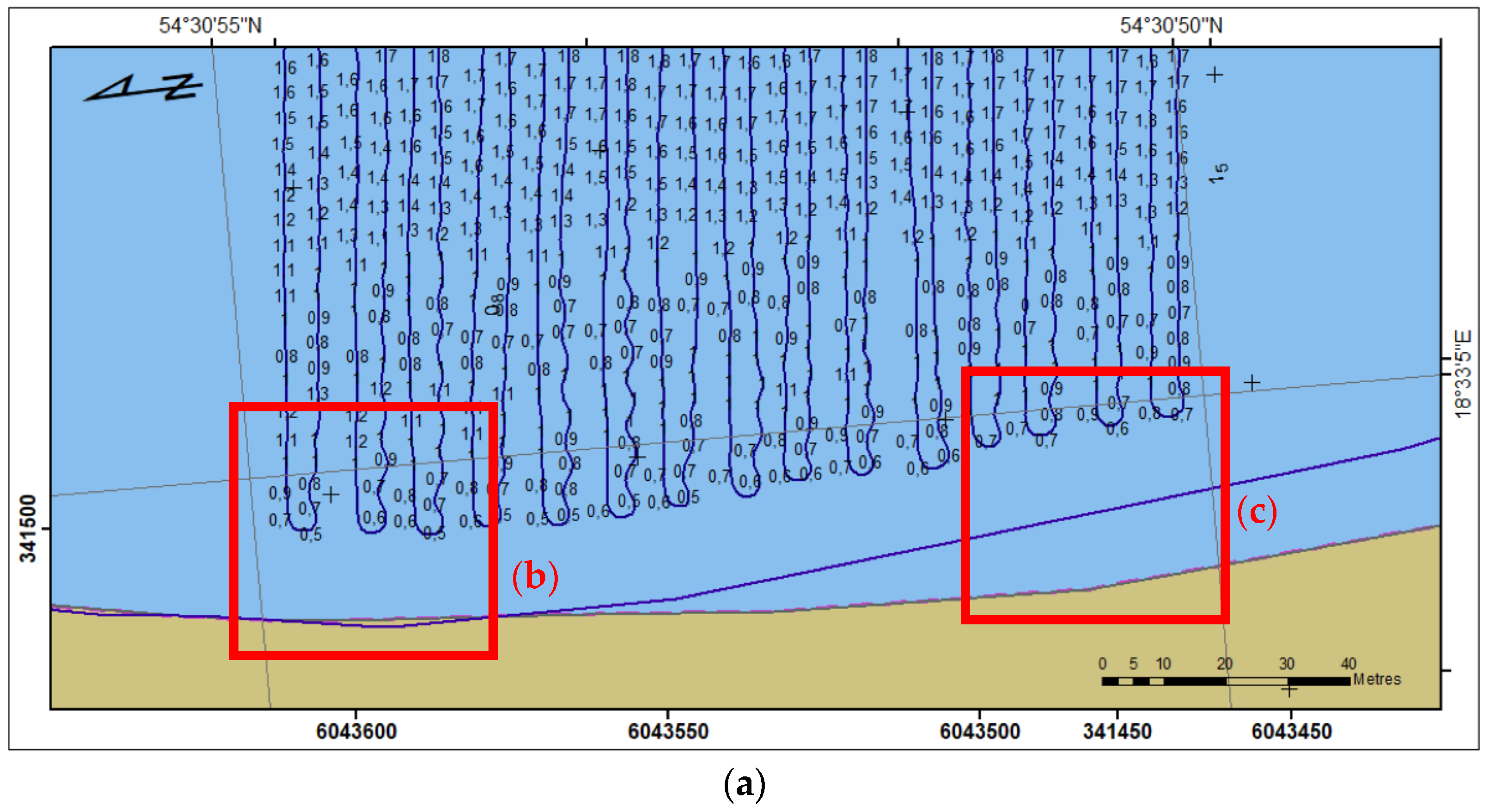

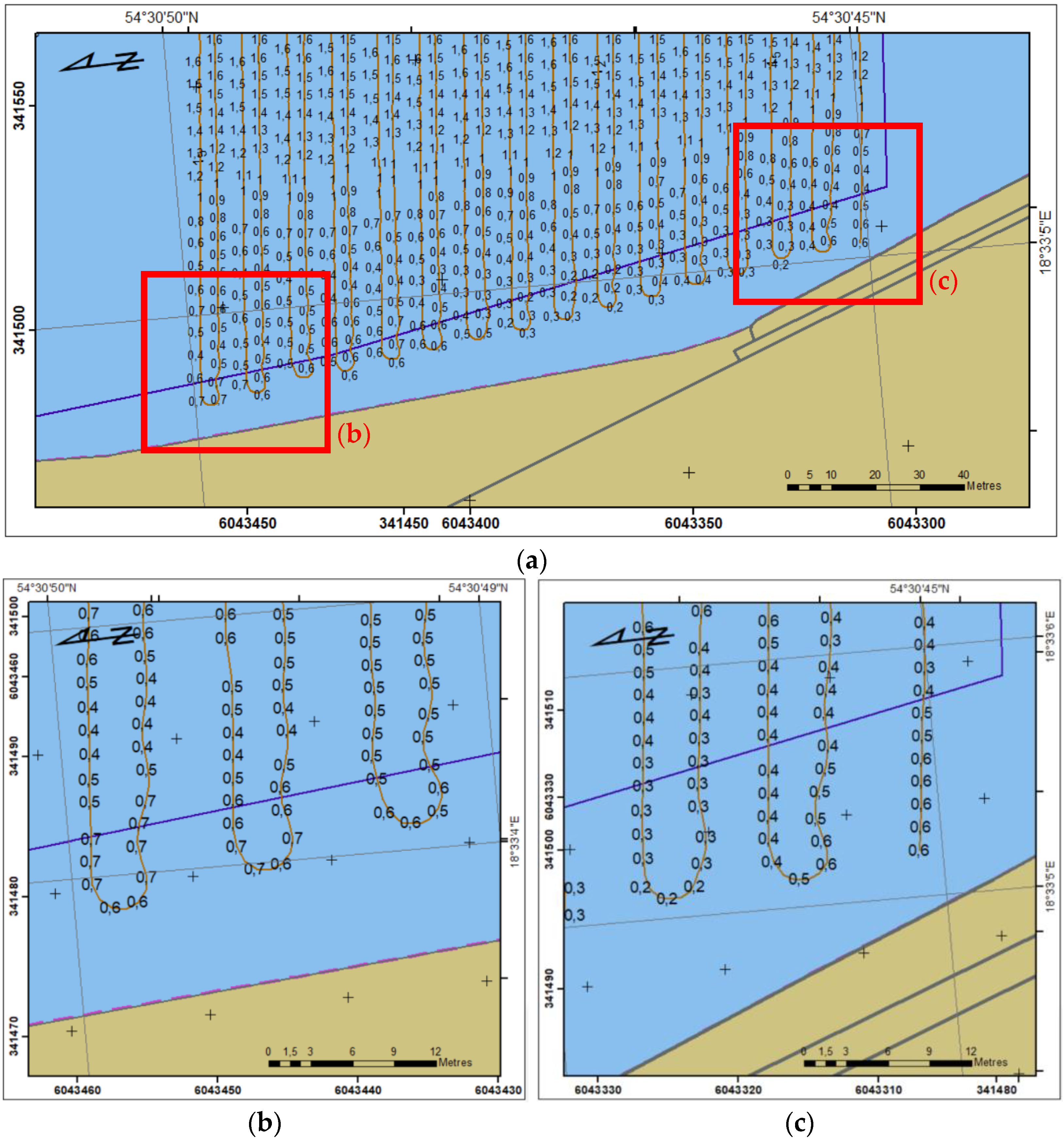
| Parameter | OceanAlpha USV SL20 |
|---|---|
| Hull material | Carbon fiber |
| Dimension | 105 cm × 55 cm × 35 cm |
| Draft | 15 cm |
| Propulsion | water-jet propulsion |
| Survey speed | 2–5 kn (1–2.5 m/s) |
| Max speed | 10 kn (5 m/s) |
| Positioning (standard—not used) | u-blox LEA-6 series |
| Positioning (used in manoeuvering) | Topcon HiPerII |
| Heading | Honeywell HMC6343 |
| Echosounder | Echologger series SBES |
| Time Area | 26.05.2020 B | 27.05.2020 - | 28.05.2020 C | 29.05.2020 A |
|---|---|---|---|---|
| 8.00 | 517 | 514 | 530.5 | 528 |
| 9.00 | 518 | 512.5 | 531 | 531 |
| 10.00 | 519 | 513 | 534 | 531 |
| 11.00 | 519 | 512.5 | 535 | 531.5 |
| 12.00 | 519.5 | 514.5 | 535 | 532 |
| 13.00 | 520 | 515.5 | 535 | 533 |
| 14.00 | 520.5 | 516.5 | 535 | 535 |
| Time | 26.05.2020 | 27.05.2020 | 28.05.2020 | 29.05.2020 |
|---|---|---|---|---|
| Water level [cm] | 519 | 513 | 535 | 531 |
| Depth correction [cm] | −20 | −15 | −35 | −30 |
| Contour line [cm] | 0 | 5 | 0 | 0 |
Disclaimer/Publisher’s Note: The statements, opinions and data contained in all publications are solely those of the individual author(s) and contributor(s) and not of MDPI and/or the editor(s). MDPI and/or the editor(s) disclaim responsibility for any injury to people or property resulting from any ideas, methods, instructions or products referred to in the content. |
© 2023 by the author. Licensee MDPI, Basel, Switzerland. This article is an open access article distributed under the terms and conditions of the Creative Commons Attribution (CC BY) license (https://creativecommons.org/licenses/by/4.0/).
Share and Cite
Makar, A. Coastal Bathymetric Sounding in Very Shallow Water Using USV: Study of Public Beach in Gdynia, Poland. Sensors 2023, 23, 4215. https://doi.org/10.3390/s23094215
Makar A. Coastal Bathymetric Sounding in Very Shallow Water Using USV: Study of Public Beach in Gdynia, Poland. Sensors. 2023; 23(9):4215. https://doi.org/10.3390/s23094215
Chicago/Turabian StyleMakar, Artur. 2023. "Coastal Bathymetric Sounding in Very Shallow Water Using USV: Study of Public Beach in Gdynia, Poland" Sensors 23, no. 9: 4215. https://doi.org/10.3390/s23094215
APA StyleMakar, A. (2023). Coastal Bathymetric Sounding in Very Shallow Water Using USV: Study of Public Beach in Gdynia, Poland. Sensors, 23(9), 4215. https://doi.org/10.3390/s23094215







